A survey of Vietnamese Ceramics
Vietnam has a long history of more than 2000 years of glazed ceramics production. The earliest wares were most likely those Han inspired wares with shapes imitating the bronze wares of the period. They are different from the Chinese early celadon wares (greenware) of the same period. The Chinese early celadon are covered with green or yellowish glaze and has grayish paste. (For more on early Chinese celadon, please read this article: Shang to Western Han celadon). The Vietnamese version has a paste which is white and covered with a whitish/light greenish glaze which pooled into greenish patches in some area on the vessel. Many such wares were recovered from Han tombs (dated to 1st century) near Thanh Hoe.
Vietnamese examples of Han-type vessels in Hanoi Museum
In 2008, archaeological surveys in Halong Tuan Chau island showed that Guangdong type green wares were produced there during the at least during the late 9th/10th century. They shared the same visual glaze appearance, form and stacking technique as those made in Guangdong Province. Some of those green wares could have been exported overseas and mistaken to be of Guangdong origin.
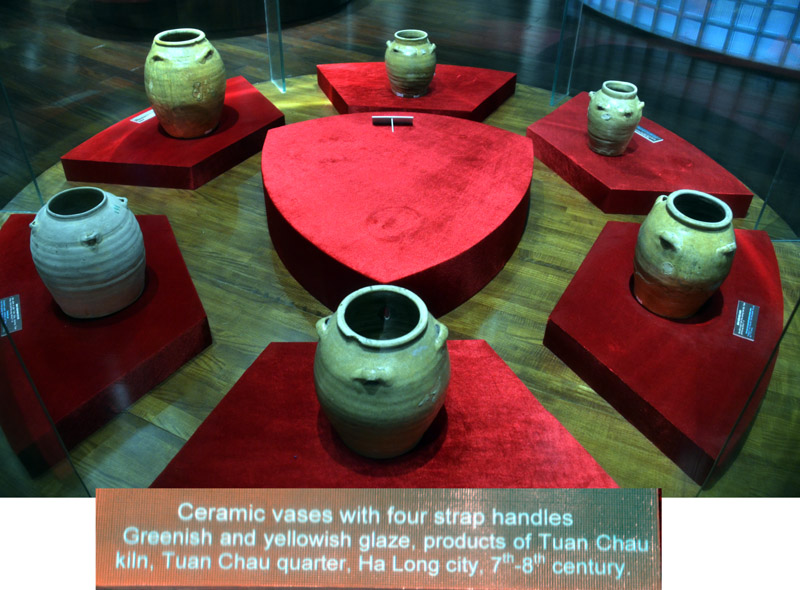
The above dating of 7th-8th century is most probably too early
The chaos during the late Tang/5 Dynasties in China provided the opportunity for the Vietnamese to break away from Chinese rule. After a series of short duration dynasties during the 10th Century, the Ly Dynasty (A.D 1009 - 1225) finally emerged to rule Vietnam. It was the first strong Dynasty that ruled Northern Vietnam for more than 200 years. During this period, there was stability and the economy prospered. The ceramics industry benefited and many interesting types of ceramics were introduced to satisfy increasing domestic demand.
Brown glaze inlaid Wares (Ly to Early Le period [11th -early 15th century])
The earliest most recognizable form of Vietnamese ceramics are those wares with brown glaze inlaid motif and a white glaze usually with tinge of green. They were produced since the Ly dynasty (AD 1009 - 1225) and continued to be produced till the early 15th Century. The origin of the technique and motif could be traced to the wares first created by the Cizhou potters of the Northern Song period. The decorative method is termed sgraffito in the West. In the basic form, the ware is first covered with a layer of slip. Outline of the motif is incised and the slip outside the motif is scrapped away. The ware is than covered with a transparent glaze and fired.
Vietnamese version of the sgraffito method is different. No layer of slip is applied. The majority of the vessels have brown glazed motif. The decoration is done in the following manner: Firstly the vessel is glazed. The outline of the motif is then incised and the glaze within removed. A layer of brown glaze is then applied on the unglaze motif. A variation has the area outside the motif removed and then applied with brown glaze.
Vietnamese brown in-laid jar (12th-13th Century)
Vietnamese brown in-laid jar (11th-13th Century)
The Vietnamese brown-inlaid wares has a distinctive Vietnamese character in terms of type and style of motif and the shape of vessels. Floral scrolls was most popular during the Ly period. A small number was decorated with pea-cock like bird motif. A distinctive characteristic of the typical jar is the ring of high relief lotus petals on the shoulder. High relief lotus petals is also popular on Chinese vessels of the Northern Song period. It is very likely that Vietnamese potters drew inspiration from the Chinese vessels and applied it on Vietnamese vessels. The range of motifs became varied during the Tran period (A.D 1225 - 1440) with interesting motif such as fish, human figures engaging in hunting or fighting, village scene with houses and even ship and etc.
Jar with Human human motif (13th-14th century)
Jar with Human bird motif (13th-14th century)
Huge Jar with human figures fighting (13th-14th Century)
Jar with floral motif (13th-14th Century)
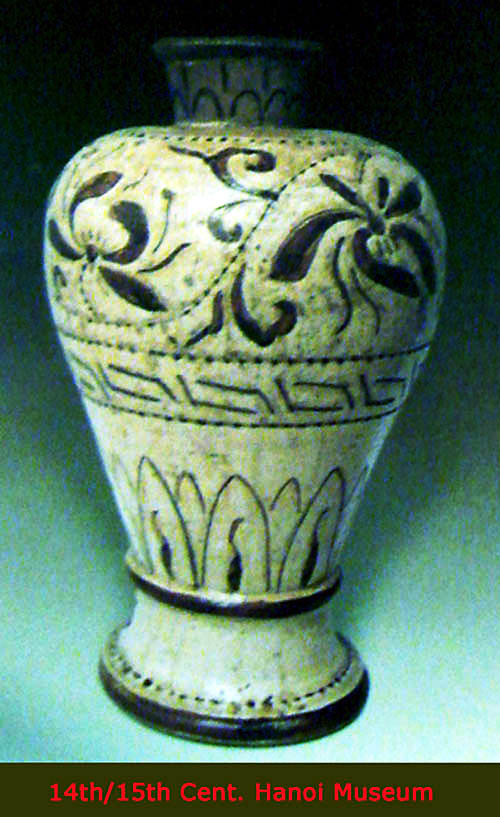
The shape of this vase is contemporaneous of those in Chinese wares
Brown glaze inlaid wares spanned a long duration from 11th to 15 Century. Past literatures dealing with this category of wares are noted for their inconsistency in the dating or simply attributing a safe date range of 11th-14th century. So far, the most comprehensive book dealing with this subject is "Vietnamese Brown Pattern Ceramics" by Prof. Nguyen Dinh Chien and Pham Quoc Quan. This is an important and interesting book with useful information relating to more accurate dating of such wares. Some useful tips offered by Prof Nguyen include the following:
Evenly embossed lotus petals around shoulder or base of vessel. The petals are carefully trimmed and finely pointed at the end. This is feature of Ly period. If the petal is large, thick and flatten and with motif of lotus flower, human figure or embossed flowers, they are more likely dated to Tran period.
Unglaze pattern engraved on brown background and with embossed pattern are features of Tran to early Le period
Motif arranged within vertical or horizontal bands formed by brown glazed dots are features of Tran to early Le period
Iron brown painted motif under whitish glaze is feature from Late Tran to Early Le period
Iron-black painted wares of the 13th/15th Century
Underglaze iron black painted decoration appeared to have only made a late entry in the second half of 13th century. The early examples have very simple floral motif and made for local consumption.
A late 13th/14th iron black painted bowl
However, by the 14th century they were exported overseas. The earliest excavated example of export iron painted floral ware was a sherd found in Dazaifu in Kyushu Japan. It was initially attributed to A.D 1330 based on inscription on a marker found together with the sherd. John Guy who first revealed the findings has since made some clarifications. The reliability of the dating has to be interpreted with caution. The marker and the sherd were found in a pond. It is not clear when the marker landed in the pond. Hence, it might not be contemporaneous of the sherd. John Guy has suggested a revised date of of about A.D 1350 in his book on Vietnamese Ceramics.
The source of decorative inspiration for export version of the ware has been much discussed. Some scholars have suggested a cizhou related or Yuan blue and white wares origin. The most common iron black painted motif has sytlised flower with leaves which is found in vessels such as bowls, plates and jarlets. They were exported in substantial quantity to country such as Philippines and Indonesia during the 14th and 15th century.
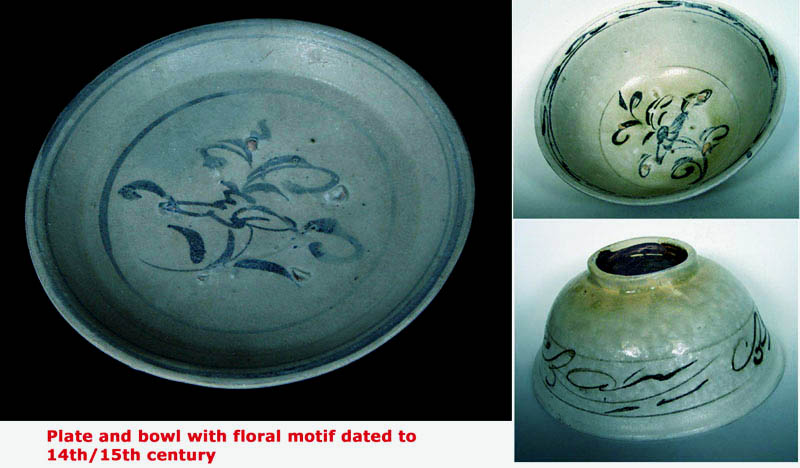
|
|
|
|
|
|
| Some examples of 14th/15th Century Vietnamese Iron-black painted wares | |
The source of the inspiration and
influence for the decoration might
be actually nearer than thought. Haikang kiln in the present day Lezhou in
Guangdong produced iron-blown/black painted wares since the Song period till Ming Hongwu
period. Some of the Haikang products were also exported overseas.
The below jar in the National Museum of Vietnamese History is most likely a
product from the Haikang kiln.
|
|
| A iron-painted jar with iron-painted motif. The Vietnamese ceramics experts are of the view that it was manufactured in Vietnam. The motif show much similarity to those from Haiking in Guangdong province of China. The possibility of Chinese origin is not far-fetched. Hence, the actual origin of the jar needs to be explored further. |
If we compare the below Haikang iron painted Jar excavated from a Yuan grave which can be dated to A.D 1338, the stylistic similarity to the Vietnamese example is striking.
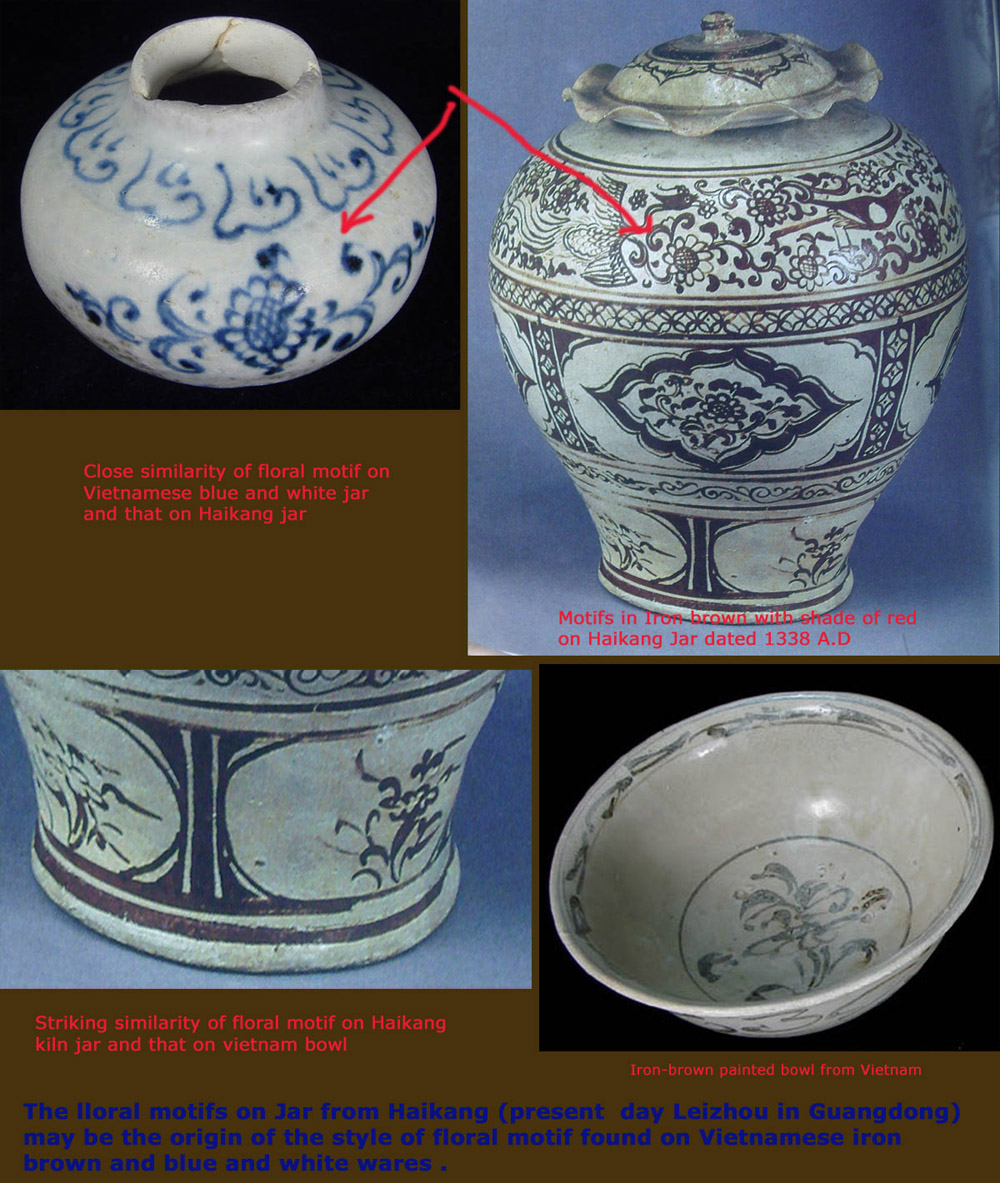
Haikang kilns in present day Lezhou were in operation since the Song Period. During the Southern Song period, foreign trade was actively promoted by the palace as tax on import and export was a lucrative source of revenue. Haikang with its proximity to the sea was known as an important port. So far, more than 50 kilns from the Song/Yuan period were discovered in Haikang. The large production suggested that there was overseas demand for their products. A number of Haikang wares with iron painted motif were also excavated from ancient graves. The latest date was a jar from a Ming Hongwu period grave. There are also other kilns in the area such as Lian Jiang and those in Hainan Island that produced iron-painted wares. The ban on foreign trade initiated during the Ming Hongwu period must have adversely impacted the production of porcelain and led to cessation of their production.
The importance and the high regard for the quality of Haikang wares is obvious. More than 10 pieces in the Leizhou Museum were graded as category 1 cultural relics. Two found in Song graves are shown below. Note the similarity of the motif of the floral motif on the jar to the Yuan example mentioned earlier. Such style of depicting floral motif has existed since then. Hence, it is not impossible that the Vietnamese iron-brown painted wares may have been produced around A.D 1330 or even earlier.

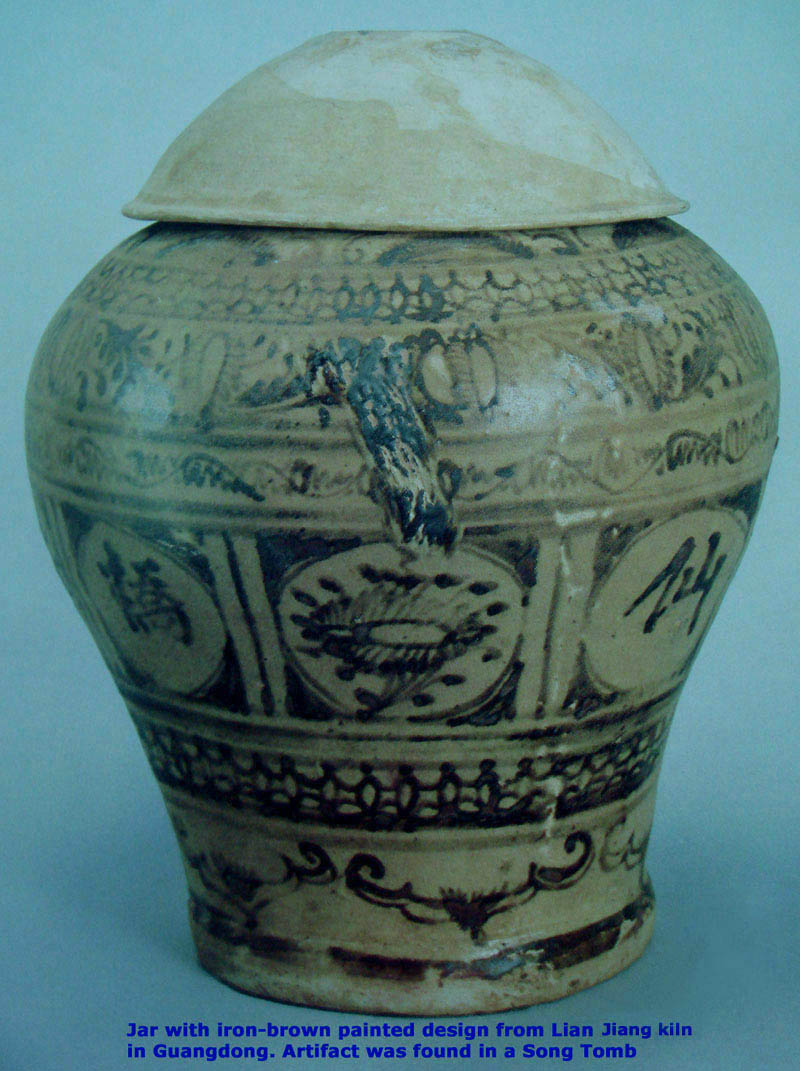
A kiln waste with stack of bowls decorated with iron-painted motif which previously belonged to the Clement Huet collection was said to have been recovered from Dai La near Hanoi. This indicates the possibility of kilns in that area which produced such iron painted wares. Clement Huet was a Belgium businessman who ran an import and export business in Vietnam. He acquired more than 5000 artifacts during his stay in Vietnam. He left Vietnam in A.D 1938. Musee Royaux d'Art et d'Historie in Brussels acquired more than 3000 pieces of his collection. 4 pieces of kiln waste were among the pieces. Recent Archaeological surveys in Vietnam revealed that similar wares wer produced at Tuc mac and Con Che kiln complex in Thien Truong situated 90 south of Hanoi, Van Yen situated 90 km east of Hanoi and Kim Lan in the vicinity of Bat Trang.
Vietnamese white/Qingbai/brown/celadon wares of 12th/14th Century
Please continue from here.
Vietnamese blue and white and enamelled wares
Please continue from here.
Written by: NK Koh (25 Nov 2009), updated:: 12 Jun 2015